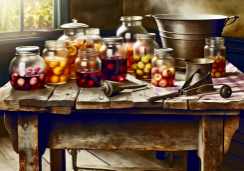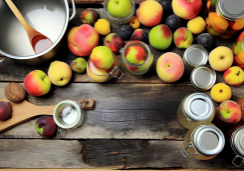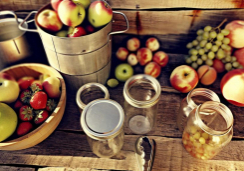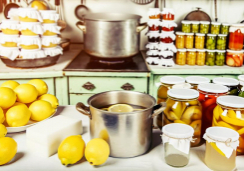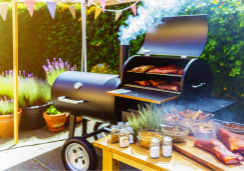What's the Key to Canning Seasonal Fruits Successfully?
As you stand at the threshold of summer's bounty, the art of canning seasonal fruits beckons like a well-worn recipe book, filled with the promise of sweet preserves and savory concoctions.
You're about to embark on a journey that marries tradition with practicality, where the vibrant flavors of orchard-fresh produce are captured in glass jars, awaiting the chill of winter.
The key to your success isn't shrouded in mystery; it's rooted in the precision of your methods and the quality of your ingredients. You'll need to consider the ripeness of your fruit, the sterility of your jars, and the timing of your process.
Yet, within these steps lies a nuance that transforms good results into great ones. Stay with me as we unpack these layers, and you'll uncover the subtleties that can elevate your canning from a mere seasonal task to a culinary triumph.
Selecting the Right Fruit
To ensure your canned creations taste as delightful as nature intended, pick fruits that are ripe and bursting with flavor at their peak freshness. The success of canning fruits hinges on using high-quality, fully ripe specimens that pack the fruit's true essence into every jar. Avoid fruits with blemishes, bruises, or mold, as these imperfections can affect the taste and compromise the preservation process.
When you're preparing the fruit for canning, consider the type of fruit you're dealing with. High-acid fruits like berries, apples, and peaches are ideal for water bath canning, a method that safely preserves their vibrant flavors and firm textures. For fruits lower in acidity, you might need to use a pressure canner to ensure food safety.
Your choice in sweetening is crucial too. Take into account the natural sweetness of the fruit. You might opt for a light sugar syrup or fruit juice instead of a heavy syrup to let the fruit's natural flavors shine. Some fruits, like cherries and apples, offer versatility and can be canned as slices, pie fillings, or even jams.
Essential Canning Supplies
Gathering a few essential supplies, such as canning jars, lids, bands, and a sturdy canning pot, will set the foundation for your fruit canning success. Before you begin, make sure you've got everything on hand to ensure a safe and effective preservation process.
Here's a concise list of what you'll need:
- Canning Jars and Lids with Bands: Quality canning jars are crucial, and the lids must have a sealing compound to ensure a tight seal. Always check for chips or cracks before use.
- Water Bath Canner or Steam Canner: For high-acid fruits, a water bath canner or a steam canner is sufficient. Ensure it's large enough to fully immerse jars and has a rack to prevent jar breakage.
- Jar Lifter or Tongs: To safely handle hot jars, a jar lifter or tongs are indispensable. They provide a secure grip when moving jars in and out of boiling water.
- Canning Funnel and Bubble Remover: A funnel aids in achieving the recommended headspace, while a bubble remover ensures proper filling, per your canning recipe.
Adhering to guidelines from the National Center for Home Food Preservation, and utilizing these supplies, will lead you toward home canning excellence.
Preparing Fruit for Canning
Having gathered your essential canning supplies, it's time to focus on the crucial step of preparing your fruits to ensure they're preserved at their freshest and most flavorful. Begin by selecting ripe, high-quality fruits and vegetables at their peak, as this will guarantee the best taste and nutritional value. Carefully wash, peel, pit, and slice the fruit according to the specific needs of each variety.
Next, prepare your canning liquid. You might use fruit juice for a natural flavor or opt for a light or heavy sugar syrup depending on the sweetness of the fruit. To prevent discoloration, consider adding commercial ascorbic acid or lemon juice.
When it's time to fill the jars with fruit, pack them tightly to minimize air pockets, leaving the recommended headspace. Pour the hot pack liquid over the fruit, ensuring the top layer of fruit is covered. This step is vital to remove any trapped air bubbles, which can compromise the seal and food safety.
Before sealing, wipe the rims to ensure safe closure. Process the jars as directed, then let them cool undisturbed. Finally, label your jars with fruit, date, and processing details, and store them in a cool, dark place.
Mastering the Canning Process
Master the art of canning seasonal fruits by understanding the nuances of different canning methods and how they relate to the types of fruit you're preserving. High acid fruits such as berries and apples are best suited for water bath canning, while lower acid fruits may require the use of pressure canners to ensure food preservation safety.
Here's a step-by-step guide:
- Prepare Your Jars: Sterilize canning jars and lids in boiling water; this is crucial for preventing contamination and ensuring your fruits are sealed properly.
- Pack the Jars: Fill jars with your chosen fruit and canning liquid, following the recipe closely. Use a canning funnel for a clean transfer and avoid overfilling.
- Remove Air Bubbles: Slide a non-metallic tool around the inside of the jar to release any trapped air bubbles. This step ensures even heat distribution during processing.
- Process Correctly: Place jars in the water bath or pressure canner. Adjust the processing time based on the fruit type and recipe instructions, and remember to make altitude adjustments if necessary.
Always ensure jars are cooled undisturbed and check that seals are intact before storing. A properly sealed jar will have a concave lid that doesn't flex when pressed.
Embrace these practices, and you'll be a canning maestro in no time.
Effective Storage Techniques
Once your jars are sealed and cooled, it's crucial to store them in a cool, dark place to maximize shelf life and maintain the quality of your canned fruits. The National Center for Home Food Preservation underscores the importance of proper storage techniques to prevent spoilage and ensure safety.
Here's what you need to do:
- First, ensure your canning jars are properly sealed. Press the center of the lid; if it doesn't flex, it's likely sealed. After the jars cool, check the seals again by removing the bands and lifting the jars by the edges of the lids. If the lid holds, your seal is secure.
- Store your canned foods away from direct sunlight, as light can degrade the quality over time. A pantry, cupboard, or basement can serve as an ideal storage space, provided it's consistently cool and not prone to drastic temperature changes. This is particularly crucial for low-acid foods, which are more susceptible to botulism if stored improperly.
- Keep the jars upright to avoid disturbing the seals or trapping air bubbles. Don't stack jars on top of one another; this can compromise the seals.
- Regularly inspect your canned goods for any signs of spoilage before use.
With these storage techniques and reliable canning equipment, your home food preservation efforts will surely pay off.
Frequently Asked Questions
What Fruits Are Seasonal for Canning?
You'll find apricots, berries, and peaches ripe for canning, considering harvest timing, regional varieties, and market availability. Choose organic to avoid pesticides, ensuring peak flavors, optimal nutritional retention, and suitable storage conditions influenced by climate.
How Do You Prepare for Canning Season?
You'll need to gather canning equipment, clear storage space, and source quality ingredients. Ensure your jars are clean and choose recipes wisely. Test pH levels for safety, and pick the right preservation method for your harvest.
What Is the Best Way to Can Fruit?
To best can fruit, you'll choose prime produce, sterilize jars, and use sugar syrups. Adjust acid levels, master peel techniques, pack efficiently, process in water baths, test seals, and store considering altitude variations.
How Do You Make Canned Fruit Better?
To enhance your canned fruit, pick ripe, blemish-free produce and consider sugar alternatives for health. Spice infusions add unique flavors, while acid balance and correct pectin levels ensure perfect texture and preservation.
Conclusion
To guarantee your canned fruits' excellence, choose prime, unblemished produce, and arm yourself with essential tools. Sterilize jars thoroughly; prepare fruits with precision.
Master the canning process, respecting time and technique, and store your bounty in a cool, dark place. Adhere to these steps, and you'll enjoy the fruits of your labor all year round.
Remember, meticulous preparation and adherence to guidelines are the cornerstones of successful canning.




